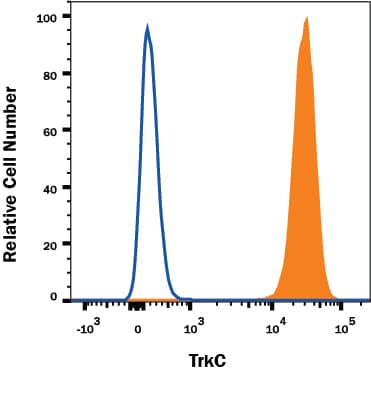Human TrkC Antibody
R&D Systems, part of Bio-Techne | Catalog # MAB3731


Key Product Details
Species Reactivity
Validated:
Cited:
Applications
Validated:
Cited:
Label
Antibody Source
Product Specifications
Immunogen
Cys32-Asp428
Accession # Q16288
Specificity
Clonality
Host
Isotype
Scientific Data Images for Human TrkC Antibody
Detection of TrkC in Human TrkC transfected cells by Flow Cytometry.
Human TrkC transfected Baf/3 cells were stained with Mouse Anti-Human TrkC Monoclonal Antibody (Catalog # MAB3731, filled histogram) or Mouse Monoclonal IgG2B isotype control antibody (Catalog # MAB0041, open histogram) followed by anti-Mouse IgG APC-conjugated secondary antibody (Catalog # F0101B). View our protocol for Staining Membrane-associated Proteins.Applications for Human TrkC Antibody
CyTOF-ready
Flow Cytometry
Sample: Human TrkC transfected Baf/3 cells
Western Blot
Sample: Recombinant Human TrkC Fc Chimera (Catalog # 373-TC)
Formulation, Preparation, and Storage
Purification
Reconstitution
Formulation
Shipping
Stability & Storage
- 12 months from date of receipt, -20 to -70 °C as supplied.
- 1 month, 2 to 8 °C under sterile conditions after reconstitution.
- 6 months, -20 to -70 °C under sterile conditions after reconstitution.
Background: TrkC
The neurotrophins, including NGF, BDNF, NT-3 and NT-4/5, constitute a group of structurally related, secreted proteins that play an important role in the development and function of the nervous system. The biological activities of the neurotrophins are mediated by binding to and activating two unrelated receptor types: the p75 neurotrophin receptor (p75NTR) and the Trk family of receptor tyrosine kinases (1, 2). P75NTR is a member of the tumor necrosis factor receptor superfamily (TNFRSF) and has been designated TNFRSF16. It binds all neurotrophins with low-affinity to transduce cellular signaling pathways that synergize or antagonize those activated by the Trk receptors. Three Trk family proteins, TrkA, TrkB and TrkC, exhibiting different ligand specificities, have been identified. TrkA binds NGF and NT‑3, TrkB binds BDNF, NT-3 and NT-4/5, and TrkC only binds NT-3 (1, 2). All Trk family proteins share a conserved, complex subdomain organization consisting of a signal peptide, two cysteine-rich domains, a cluster of three leucine-rich motifs, and two immunoglobulin-like domains in the extracellular region, as well as an intracellular region that contains the tyrosine kinase domain (3). Natural splice variants of the different Trks, lacking the first cysteine-rich domain, the first and second or all three of the leucine-rich motifs, or the tyrosine kinase domain, have been described (4). At the protein sequence level, Trks are highly conserved between species with the extracellular domains of human and mouse TrkC's showing 94% amino acid sequence identity (5). The proteins also exhibit cross-species activity. The primary location of TrkC expression is in the nervous system and, specifically, in regions of the CNS. Low level TrkC expression has also been observed in a wide variety of tissues outside the nervous system (6).
References
- Huang, E.J. and L.F. Reichardt. (2003) Annu. Rev. Biochem. 72:(epub ahead of print).
- Dechant, G. (2001) Cell Tissue Res. 305:229.
- Schneider, R. and M. Schweiger (1991) Oncogene 6:1807.
- Ninkina, N. et al. (1997) J. Biol. Chem. 272:13019.
- Menn, B. et al. (1998) J. Comp. Neurol. 401:47.
- Shelton, D. et al. (1995) J. Neurosci. 15:477.
Long Name
Alternate Names
Gene Symbol
UniProt
Additional TrkC Products
Product Documents for Human TrkC Antibody
Product Specific Notices for Human TrkC Antibody
For research use only